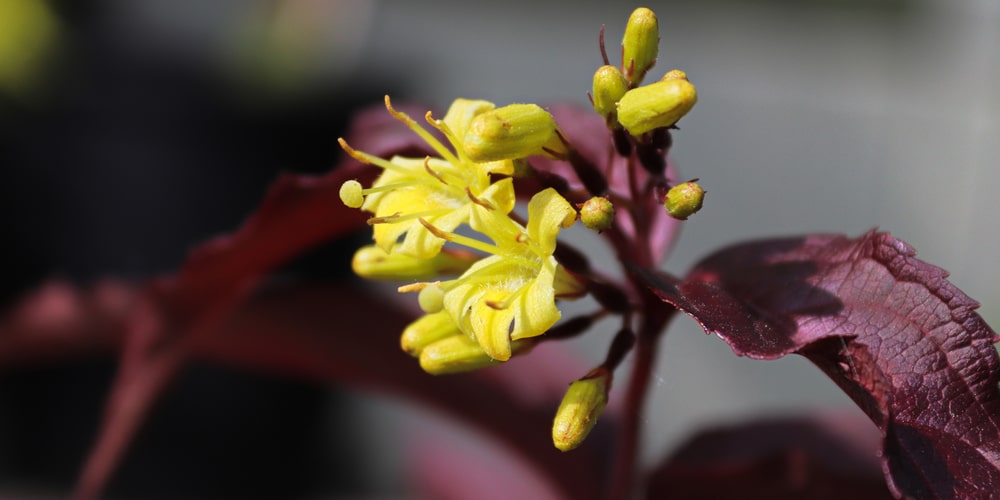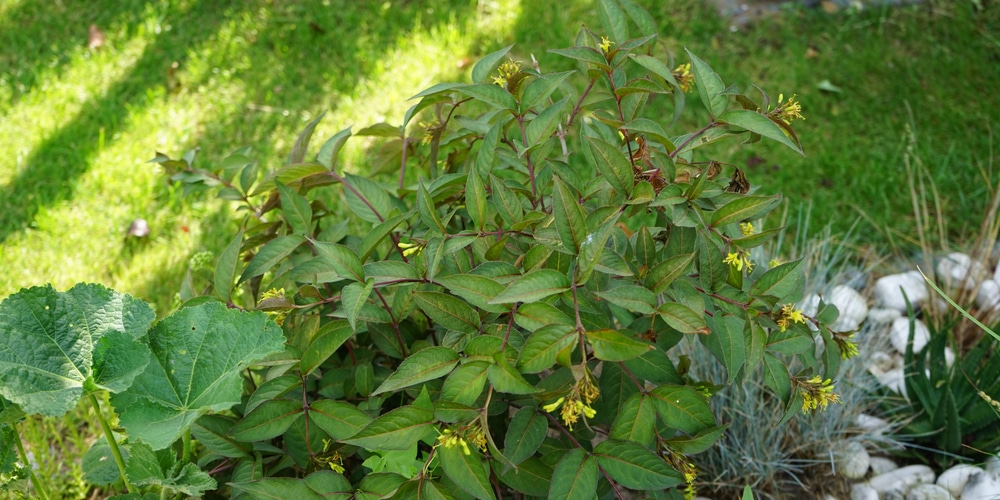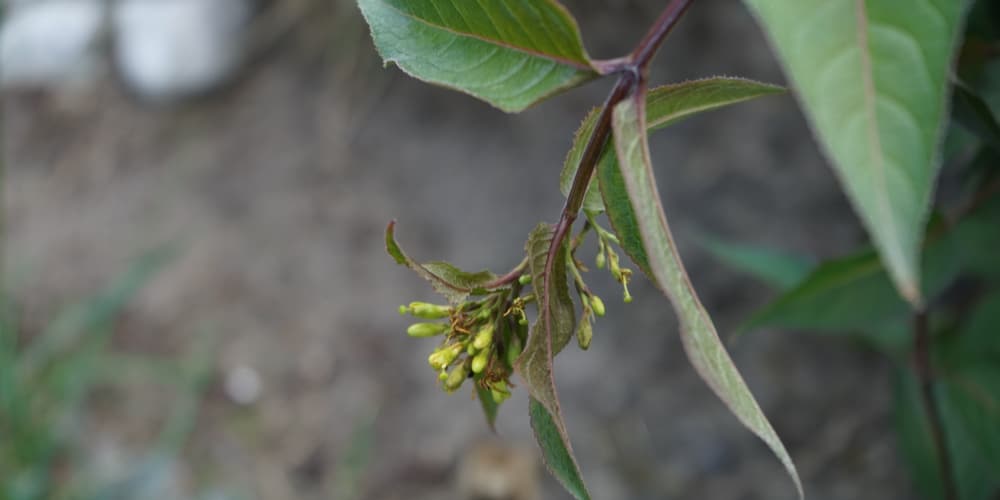Not all plants give off a vibrant green hue. The Nightglow Diervilla, also known as bush honeysuckle, brings a splash of yellow to gardens against its dramatic foliage. Native to North America, this deciduous shrub is a low-maintenance plant that’s easy to grow. Prized for its moody color and summer blooming period, this perennial is a standout in any landscape.

| Botanical Name | Diervilla Splendens |
| Common Name | Nightglow Diervilla, Bush Honeysuckle |
| Plant Type | Perennial |
| Flower Color | Golden yellow blossoms |
| Size When Mature | 24 – 36 inches |
| Bloom Time | Early Summer to Late Fall |
| Sun Requirements | Full Sun, Partial Shade |
| USDA Hardiness Zones | 4 -8 |
| Soil PH Range | 6 – 8 |
| Soil Type | Sandy, fertile, well-draining, moist |
| Water Needs | Medium |
| Native Area | North America |
What You Need to Know About Nightglow Diervilla
Considered to be one of the most stunning plants in the Diervilla genus, Nightglow Diervilla is a must-have for any shrub enthusiast. Its deep burgundy foliage and bright yellow blooms prove that opposites DO attract!
Its leaves are large, ovate, and deeply veined with a toothed margin. The undersides of the leaves are a rich purple color, making an interesting contrast when the breeze blows. Blooming during the summer throughout the fall season, Nightglow Diervilla produces small, tubular flowers that are a beautiful golden color.
This shrub is a slow grower, reaching only 3-4 feet. It’s perfect for border plantings and foundation plantings. In some cases, they’re used as groundcover.
It can grow and thrive in acidic, neutral, and saline soil conditions and even survive in drought-like conditions. It’s a perfect plant for those who want something easy to take care of and doesn’t require much attention.
How to Care for Nightglow Diervilla
Here’s everything you need to know about growing and caring for a thriving Nightglow Diervilla bush:
Light
The nectar-filled tubular flowers of the Nightglow Diervilla are a favorite among hummingbirds and bees. If you want your plant to overflower during its blooming season, it’s best to provide it with at least 6-8 hours of sunlight daily.
Its ability to produce vibrant golden blooms depends on the amount of sunlight it receives. Ideally, ensure that your plant gets full sunlight or is in a slightly shaded area to enjoy an abundance of flowers.
Water and Soil Needs
One of the best things about the Nightglow Diervilla is that it’s drought resistant. This means that you won’t have to water it as often as other plants. It only needs regular watering during its first growing season, after which it will be able to survive on rainfall or supplemental irrigation.
Additionally, this shrub can grow in different types of soil, including clay, loamy, and sandy soils. While it thrives in moist soils, this plant will do just fine, even in dry conditions.
You don’t have to worry about the soil pH either! It has a wide range of 6 -8 pH, so it can adapt to different types of soil conditions.
Temperature Requirements
Like other sun-loving plants, the honeysuckle bush is happy and grows well in subtropical regions. Hardy in USDA zones 4-8, the plant loves the warm weather, with its ideal temperature range falling between -20 and 10 degrees Fahrenheit.
Once the temperature has reached 10 degrees, the growth of the plant will start to slow down, and some of its leaves will start to yellow. It’s an indication that the weather is too hot for the plant to handle. You can give it some afternoon shade in the form of thin cloth or umbrella to help it survive the heat.
Fertilizer
The best fertilizer to use on a Nightglow Diervilla is organic compost. It doesn’t need much fertilizer, only requiring you to feed it once a year in the spring. If you live in an area with poor soil quality, you can opt to give it a little bit more compost to help it grow better. You may also get by with a slow-release all-purpose fertilizer. A ratio of 16-16-16 or 10-10-10 would be perfect for this plant.
Common Diseases
Fungal and bacterial infections are the common problems that may affect your Nightglow Diervilla. Some of the diseases that could potentially infect your plant include Herpobasidium, leaf blight, Microsphaera, crown gall, and powdery mildew.
The good news is, preventing these from happening is quite easy. You just have to ensure that your plant is getting the right amount of sunlight and water while ensuring that it’s growing in well-draining soil. Additionally, it’s important to make sure that the area around your plant is free from debris and dead leaves to reduce the risk of fungal growth.
Nightglow Diervilla Propagation
One of the best things about Nightglow Diervilla is that it’s easy to propagate. You can do so through stem cuttings, which is the preferred method by most gardeners. Simply cut about 4 inches. Take this from a new growth that’s just starting to harden off. You can use plain water to proceed with the propagation because these plants take root easily.
Water provides the amount of moisture your propagated stems need, but remember to change the water every week. Don’t let it sit on stagnant water because it will only encourage the growth of bacteria, not to mention that this only makes the water oxygen deficient.
If you want to use a rooting hormone, that’s fine, too. It will only speed up the process, but it’s not necessary.
Place your cutting in a well-draining potting mix and water lightly once the roots have grown. Keep the potting mix moist enough to keep the roots from drying. Carefully introduce your new plant to the outdoors once it has developed several leaves. Start with two hours of sunlight and gradually increase this amount every day until your plant can tolerate a full day of sun.


